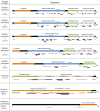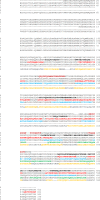Interrogating the Venom of the Viperid Snake Sistrurus catenatus edwardsii by a Combined Approach of Electrospray and MALDI Mass Spectrometry
- PMID: 25955844
- PMCID: PMC4425365
- DOI: 10.1371/journal.pone.0092091
Interrogating the Venom of the Viperid Snake Sistrurus catenatus edwardsii by a Combined Approach of Electrospray and MALDI Mass Spectrometry
Abstract
The complete sequence characterization of snake venom proteins by mass spectrometry is rather challenging due to the presence of multiple isoforms from different protein families. In the present study, we investigated the tryptic digest of the venom of the viperid snake Sistrurus catenatus edwardsii by a combined approach of liquid chromatography coupled to either electrospray (online) or MALDI (offline) mass spectrometry. These different ionization techniques proved to be complementary allowing the identification a great variety of isoforms of diverse snake venom protein families, as evidenced by the detection of the corresponding unique peptides. For example, ten out of eleven predicted isoforms of serine proteinases of the venom of S. c. edwardsii were distinguished using this approach. Moreover, snake venom protein families not encountered in a previous transcriptome study of the venom gland of this snake were identified. In essence, our results support the notion that complementary ionization techniques of mass spectrometry allow for the detection of even subtle sequence differences of snake venom proteins, which is fundamental for future structure-function relationship and possible drug design studies.
Conflict of interest statement
Figures



Similar articles
-
Nanofractionation Analytics for Comparing MALDI-MS and ESI-MS Data of Viperidae Snake Venom Toxins.Toxins (Basel). 2024 Aug 21;16(8):370. doi: 10.3390/toxins16080370. Toxins (Basel). 2024. PMID: 39195780 Free PMC article.
-
Snake venomics of Bitis species reveals large intragenus venom toxin composition variation: application to taxonomy of congeneric taxa.J Proteome Res. 2007 Jul;6(7):2732-45. doi: 10.1021/pr0701714. Epub 2007 Jun 9. J Proteome Res. 2007. PMID: 17559253
-
Venom peptide analysis of Vipera ammodytes meridionalis (Viperinae) and Bothrops jararacussu (Crotalinae) demonstrates subfamily-specificity of the peptidome in the family Viperidae.Mol Biosyst. 2011 Dec;7(12):3298-307. doi: 10.1039/c1mb05309d. Epub 2011 Sep 29. Mol Biosyst. 2011. PMID: 21959992
-
Snake venomics. Strategy and applications.J Mass Spectrom. 2007 Nov;42(11):1405-14. doi: 10.1002/jms.1242. J Mass Spectrom. 2007. PMID: 17621391 Review.
-
Insights into and speculations about snake venom metalloproteinase (SVMP) synthesis, folding and disulfide bond formation and their contribution to venom complexity.FEBS J. 2008 Jun;275(12):3016-30. doi: 10.1111/j.1742-4658.2008.06466.x. Epub 2008 May 8. FEBS J. 2008. PMID: 18479462 Review.
Cited by
-
De Novo Assessment and Review of Pan-American Pit Viper Anticoagulant and Procoagulant Venom Activities via Kinetomic Analyses.Toxins (Basel). 2019 Feb 6;11(2):94. doi: 10.3390/toxins11020094. Toxins (Basel). 2019. PMID: 30736322 Free PMC article. Review.
-
Colubrid Venom Composition: An -Omics Perspective.Toxins (Basel). 2016 Jul 23;8(8):230. doi: 10.3390/toxins8080230. Toxins (Basel). 2016. PMID: 27455326 Free PMC article. Review.
-
Full-Length Venom Protein cDNA Sequences from Venom-Derived mRNA: Exploring Compositional Variation and Adaptive Multigene Evolution.PLoS Negl Trop Dis. 2016 Jun 9;10(6):e0004587. doi: 10.1371/journal.pntd.0004587. eCollection 2016 Jun. PLoS Negl Trop Dis. 2016. PMID: 27280639 Free PMC article.
-
Trends in the Evolution of Snake Toxins Underscored by an Integrative Omics Approach to Profile the Venom of the Colubrid Phalotris mertensi.Genome Biol Evol. 2016 Aug 16;8(8):2266-87. doi: 10.1093/gbe/evw149. Genome Biol Evol. 2016. PMID: 27412610 Free PMC article.
-
The Sequence and Three-Dimensional Structure Characterization of Snake Venom Phospholipases B.Front Mol Biosci. 2020 Aug 5;7:175. doi: 10.3389/fmolb.2020.00175. eCollection 2020. Front Mol Biosci. 2020. PMID: 32850964 Free PMC article.
References
-
- Lukas RJ, Morimoto H, Hanley MR, Bennett EL (1981) Radiolabeled alpha-bungarotoxin derivatives: kinetic interaction with nicotinic acetylcholine receptors. Biochemistry 20: 7373–7378. - PubMed
-
- Calvete JJ, Ghezellou P, Paiva O, Matainaho T, Ghassempour A, et al. (2012) Snake venomics of two poorly known Hydrophiinae: Comparative proteomics of the venoms of terrestrial Toxicocalamus longissimus and marine Hydrophis cyanocinctus . J Proteomics 75: 4091–4101. 10.1016/j.jprot.2012.05.026 - DOI - PubMed
-
- Holycross AT, Mackessy SP (2002) Variation in the diet of Sistrurus catenatus (Massasauga), with emphasis on Sistrurus catenatus edwardsii (Desert Massasauga). J Herpetol 36: 454–464.
Publication types
MeSH terms
Substances
LinkOut - more resources
Full Text Sources
Other Literature Sources

